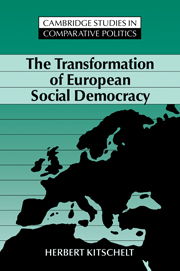Book contents
- Frontmatter
- Contents
- List of tables and figures
- Preface
- Glossary of political parties by country
- Introduction
- 1 Social structure and collective preference formation: Opportunities for left party strategy in the 1970s and 1980s
- 2 Class structure and left party performance
- 3 Political economy and left party fortunes
- 4 Social democratic strategy and electoral competition
- 5 Internal politics in socialist parties: Preference formation, aggregation, and strategic choice
- 6 The socialist discourse: Political semantics and party strategy
- 7 Social democracy in decline? Analytical and normative extensions of the argument
- References
- Index
5 - Internal politics in socialist parties: Preference formation, aggregation, and strategic choice
Published online by Cambridge University Press: 08 January 2010
- Frontmatter
- Contents
- List of tables and figures
- Preface
- Glossary of political parties by country
- Introduction
- 1 Social structure and collective preference formation: Opportunities for left party strategy in the 1970s and 1980s
- 2 Class structure and left party performance
- 3 Political economy and left party fortunes
- 4 Social democratic strategy and electoral competition
- 5 Internal politics in socialist parties: Preference formation, aggregation, and strategic choice
- 6 The socialist discourse: Political semantics and party strategy
- 7 Social democracy in decline? Analytical and normative extensions of the argument
- References
- Index
Summary
The theory of party competition explored in the previous chapter can explain how party strategies translate into electoral payoffs within a competitive situation. But the theory only insufficiently illuminates the parties' choice of strategy itself. How do social democratic parties choose among the potential goals of oligopolistic competition, short-term vote seeking, and office seeking? And why are their strategies sometimes irrational in light of the feasible courses of action?
In this chapter, I argue that intraparty decision-making processes and coalitions explain the parties' strategic appeal. Because systemic considerations account for the electoral consequences of parties' stances, my dependent variable here is the party strategy itself, not electoral performance. Once parties are viewed as miniature political systems with contending actors, electoral strategies may make sense when they would not if parties were unitary actors. Party organization and internal politics affect a party's effort to seek votes as well as its strategic view of office seeking and coalition building with other parties.
Party organization affects two different attributes of party strategy that are often distinguished insufficiently, the substantive direction and the temporal stability, flexibility, or even volatility of party appeals. Organizational rules directly affect a party's temporal strategic flexibility vis-à-vis new competitive challenges. They determine how quickly “dominant coalitions” inside parties can be displaced by new contenders. The substantive direction of a party's strategic appeal, however, depends more on the distribution of political sentiments among party activists that are by and large shaped by the political setting in which a party operates.
- Type
- Chapter
- Information
- The Transformation of European Social Democracy , pp. 207 - 253Publisher: Cambridge University PressPrint publication year: 1994

